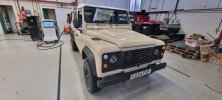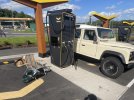EV Defender
New Member
I am living the same nightmare as you, I am getting a 2011 Defender converted to Electric but cannot find insurance. I called ERS but they only deal with brokers. Which broker did you use or how did you manage to get a quote from ERS directly? ThanksBrief update on the E-Landy conversion, and that is that I am a proud owner of a successful MOT certificate for 'Fendi' ... without the need for an inspection, which helped tremendously! Plus, after a lot of trial, error and disappointment, I've finally managed to secure insurance with a specialist insurer (ERS). With both of those steps successfully navigated, the collection date has been set and ECC are completing the final systems testing.
E~FENDER
Active Member
I eventually went through Classic Line who were incredibly helpful. Had to jump through a few hoops being a classic and more valuable than previously, but got there eventually.I am living the same nightmare as you, I am getting a 2011 Defender converted to Electric but cannot find insurance. I called ERS but they only deal with brokers. Which broker did you use or how did you manage to get a quote from ERS directly? Thanks
Been meaning to do an update on here recently, but haven't found the time --- but hugely enjoying the EV Landy; it certainly turns some heads when we reverse into public chargers!
Alibro
Well-Known Member
It didn't happen if we can't see the photo's and videos!I eventually went through Classic Line who were incredibly helpful. Had to jump through a few hoops being a classic and more valuable than previously, but got there eventually.
Been meaning to do an update on here recently, but haven't found the time --- but hugely enjoying the EV Landy; it certainly turns some heads when we reverse into public chargers!
Well done mate, I'm sure you also get a kick out of driving past folk who can't understand why it's so quiet.
EV Defender
New Member
Thanks, unfortunately this is where I am struggling, 2011 isn't classic enough and everyone else is scared of insurer either a defender or a conversion.I eventually went through Classic Line who were incredibly helpful. Had to jump through a few hoops being a classic and more valuable than previously, but got there eventually.
Been meaning to do an update on here recently, but haven't found the time --- but hugely enjoying the EV Landy; it certainly turns some heads when we reverse into public chargers!
Glad to hear you are enjoying, I'm sure it does turn heads.
E~FENDER
Active Member
August 2024
Right, after much fannying around I’ve managed to put fingers to keyboard to give you all an update on the electric 110. We took official receipt of the car in March this year. To steal a quote from higher up in the thread, there had been a few bugs to iron out and a broken steering bar to replace after final testing, and a couple of cancelled trips down to Wales. But I hopped on the train with the kids and drove it home without incident.
Work Roundup:
So since it was originally assembled in South Africa in the late 80’s, it has spent the bulk of its time in RSA and as such was in great nick. However, there was some work needed to the bulkhead and I’ve subsequently been working through my own campaign of ‘waterproofing’ the car. Mainly the gradual replacement of seals and plenty of clear sealant, but also a plan to install single piece rear windows.
Otherwise, as you’ll have seen earlier in the thread, all of the ICE gubbins have been removed, and a Tesla Model3 motor and full 100kW battery pack installed, along with various battery management systems. The motor has taken the place of the transfer box, turned 90 degrees running both prop shafts and retaining full time 4x4. It has also removed the need for the tunnel, so we’ve added a central front seat with proper legroom. The batteries are split with 60% under the (new lightweight Puma) bonnet and 40% in the load space. Initially I was a little worried this would remove the load capacity of the rear space, but as we didn’t need the flip down seats this hasn’t been the case, and I’ve tested this on a number of family camping trips this summer.
The axles have been replaced with reconditioned axles, and brakes updated to discs. However, we did have one teething issue with those on one occasion recently, when they looked due to a snapped motor spindle (a bad batch received by the OEM supplier apparently) which meant a new set of rear calliper had to be installed for the electronic handbrake.
Otherwise, I have been working through a small list of cosmetic items I’m trying to do in any spare time I have (very limited!), noting this will be an ongoing project/hobby for some time.
Usage (the good, the bad and the ugly!):
The car was collected with around 200 test miles on it, and we’ve covered a fair few more since then. The bulk of these have been trouble free, and all of them an adventure. While the acceleration is lightning fast, the comfortable speed around corners and in a straight line does not change from standard. It’s a Landy after all! Acceleration can be controlled with an app which Tesla owners will be familiar with, from “leisurely” which is probably hot hatch fast, through to “insane” which is Porsche quick! Clearly this isn’t needed much but fun now and then to brown the trousers.
Also possible within the app is the manipulation of the regen braking. This has been a great feature when driving an EV. Once you take your foot off the accelerator the motor works in reverse essentially, helping slow the car whilst also reducing energy use, and on steeper hills even helping provide a bit of on route charging. Unsure if those following me know I’m braking (probably needs to be considered!), but it does mean the use of the new brake callipers is minimal, so their longevity is increased. Clever.
Range:
Let’s be honest, range was never going to be great. Even a V8 with the aerodynamics of a garden shed would struggle on a motorway at 60+mph. After a couple of thousand miles up and down the country primarily on the A1 though, I’ve worked out that it will happily do 90miles at 60-65mph from fully charged down to 20%. Unlike standard EV’s the system is setup so that it starts to depower around 15% to save the batteries. This does limit the range a bit, but overall maintains the hardware - but it came as quite a shock at 23:00 on the M1 a couple of months ago! On slower A roads and around town (<50mph) the range picks up, and looks be be closer to 120miles. So, just like petrol/diesel, the more efficiently one accelerates and handles, the more juice we can squeeze out of the electrons.
Charging:
There are plenty of articles on charging infrastructure out there covering both sides of the argument … and they are all correct. In general the charging infrastructure is not ready for mass EV take up … and in some instances what is there - especially the older units - are in poor shape or not user friendly. However! Things are changing fast! I have travelled up and down the A1 for 25yrs and in the last 2-3yrs the banks of 300kW+ Gridserve, Applegreen, Fastned and public use Tesla charger has exploded. Our car is limited to charging at 190amps, which means our draw tops out at around 75kW/h. However, even that is sufficient to get us from 20-90% in around under 45mins. That also tends to be the time it takes to have a pee, grab some food and a bit of a rest. True, we have to do that twice as often as a standard EV, and it’s not ideal, but we didn’t do this for to create a long distance touring car, and as I learnt living in Uganda, “there’s no hurry in Africa” and “always pack a camp chair!”
I’m general, we tend to mix our charging. Some rapid (50kW+) here, some slower 7kW there. This is often down to cost, speed and availability. We do have solar at home, and when we are able to park outside, we granny charge from the house. Initially we had a few issues with this, and discovered a few bugs in the firmware, but now these have been straightened out by the supplier via ECC, this has become a really useful overnight solution, especially when visiting rural friends and family. Waking up to a full tank of electrons is always pleasant. Equally with the rise in renewables across the UK, firms like Octopus are partnering with charging operators, so that when there is abundant green power being supplied to the grid, charging prices plunge by 10-20% or they offer you periods of 'free power' at home. Hope to see more of this over time.
Cost:
Aside from the upfront cost, which I’ve nearly made peace with (not sure the wife has though), it is free of tax for now and around about half the cost to drive (charging vs fuel - this would be less if we could charge more at home). The kicker is the insurance. Due to the rise in value and rarity of these conversions the premium is high. But probably on a par with some of the newer range rovers at the moment. I hope that this may fall over time, and as the market settles, and with more conversions hitting the streets who knows.
Another cost is due to the stipulations of the insurer (@EV Defender something to note) which require the landy to be securely stored. This is something I didn’t take into account originally, but actually, I managed to find a very reasonable solution and it does keeps the car out of the worst of the Scottish weather when not in use, so probably a good thing.
All in all, so far it has been a bit of a roller coaster, trying to scrabble together the money, hit with hurdles like insurance and some teething issues, but I feel like I’m getting to understand the car more now and starting to really enjoy it. I grant you, it isn't the most practical car, but it is great fun, and a really talking point as you reverse silently into an EV charging bay! This has been the scene of some great chats with people - defender owners and non-landy people.
I’ll trying and keep you updated on the journey, but leave you with some photos for now (ps; the pink house is definitely not ours!)
Right, after much fannying around I’ve managed to put fingers to keyboard to give you all an update on the electric 110. We took official receipt of the car in March this year. To steal a quote from higher up in the thread, there had been a few bugs to iron out and a broken steering bar to replace after final testing, and a couple of cancelled trips down to Wales. But I hopped on the train with the kids and drove it home without incident.
Work Roundup:
So since it was originally assembled in South Africa in the late 80’s, it has spent the bulk of its time in RSA and as such was in great nick. However, there was some work needed to the bulkhead and I’ve subsequently been working through my own campaign of ‘waterproofing’ the car. Mainly the gradual replacement of seals and plenty of clear sealant, but also a plan to install single piece rear windows.
Otherwise, as you’ll have seen earlier in the thread, all of the ICE gubbins have been removed, and a Tesla Model3 motor and full 100kW battery pack installed, along with various battery management systems. The motor has taken the place of the transfer box, turned 90 degrees running both prop shafts and retaining full time 4x4. It has also removed the need for the tunnel, so we’ve added a central front seat with proper legroom. The batteries are split with 60% under the (new lightweight Puma) bonnet and 40% in the load space. Initially I was a little worried this would remove the load capacity of the rear space, but as we didn’t need the flip down seats this hasn’t been the case, and I’ve tested this on a number of family camping trips this summer.
The axles have been replaced with reconditioned axles, and brakes updated to discs. However, we did have one teething issue with those on one occasion recently, when they looked due to a snapped motor spindle (a bad batch received by the OEM supplier apparently) which meant a new set of rear calliper had to be installed for the electronic handbrake.
Otherwise, I have been working through a small list of cosmetic items I’m trying to do in any spare time I have (very limited!), noting this will be an ongoing project/hobby for some time.
Usage (the good, the bad and the ugly!):
The car was collected with around 200 test miles on it, and we’ve covered a fair few more since then. The bulk of these have been trouble free, and all of them an adventure. While the acceleration is lightning fast, the comfortable speed around corners and in a straight line does not change from standard. It’s a Landy after all! Acceleration can be controlled with an app which Tesla owners will be familiar with, from “leisurely” which is probably hot hatch fast, through to “insane” which is Porsche quick! Clearly this isn’t needed much but fun now and then to brown the trousers.
Also possible within the app is the manipulation of the regen braking. This has been a great feature when driving an EV. Once you take your foot off the accelerator the motor works in reverse essentially, helping slow the car whilst also reducing energy use, and on steeper hills even helping provide a bit of on route charging. Unsure if those following me know I’m braking (probably needs to be considered!), but it does mean the use of the new brake callipers is minimal, so their longevity is increased. Clever.
Range:
Let’s be honest, range was never going to be great. Even a V8 with the aerodynamics of a garden shed would struggle on a motorway at 60+mph. After a couple of thousand miles up and down the country primarily on the A1 though, I’ve worked out that it will happily do 90miles at 60-65mph from fully charged down to 20%. Unlike standard EV’s the system is setup so that it starts to depower around 15% to save the batteries. This does limit the range a bit, but overall maintains the hardware - but it came as quite a shock at 23:00 on the M1 a couple of months ago! On slower A roads and around town (<50mph) the range picks up, and looks be be closer to 120miles. So, just like petrol/diesel, the more efficiently one accelerates and handles, the more juice we can squeeze out of the electrons.
Charging:
There are plenty of articles on charging infrastructure out there covering both sides of the argument … and they are all correct. In general the charging infrastructure is not ready for mass EV take up … and in some instances what is there - especially the older units - are in poor shape or not user friendly. However! Things are changing fast! I have travelled up and down the A1 for 25yrs and in the last 2-3yrs the banks of 300kW+ Gridserve, Applegreen, Fastned and public use Tesla charger has exploded. Our car is limited to charging at 190amps, which means our draw tops out at around 75kW/h. However, even that is sufficient to get us from 20-90% in around under 45mins. That also tends to be the time it takes to have a pee, grab some food and a bit of a rest. True, we have to do that twice as often as a standard EV, and it’s not ideal, but we didn’t do this for to create a long distance touring car, and as I learnt living in Uganda, “there’s no hurry in Africa” and “always pack a camp chair!”
I’m general, we tend to mix our charging. Some rapid (50kW+) here, some slower 7kW there. This is often down to cost, speed and availability. We do have solar at home, and when we are able to park outside, we granny charge from the house. Initially we had a few issues with this, and discovered a few bugs in the firmware, but now these have been straightened out by the supplier via ECC, this has become a really useful overnight solution, especially when visiting rural friends and family. Waking up to a full tank of electrons is always pleasant. Equally with the rise in renewables across the UK, firms like Octopus are partnering with charging operators, so that when there is abundant green power being supplied to the grid, charging prices plunge by 10-20% or they offer you periods of 'free power' at home. Hope to see more of this over time.
Cost:
Aside from the upfront cost, which I’ve nearly made peace with (not sure the wife has though), it is free of tax for now and around about half the cost to drive (charging vs fuel - this would be less if we could charge more at home). The kicker is the insurance. Due to the rise in value and rarity of these conversions the premium is high. But probably on a par with some of the newer range rovers at the moment. I hope that this may fall over time, and as the market settles, and with more conversions hitting the streets who knows.
Another cost is due to the stipulations of the insurer (@EV Defender something to note) which require the landy to be securely stored. This is something I didn’t take into account originally, but actually, I managed to find a very reasonable solution and it does keeps the car out of the worst of the Scottish weather when not in use, so probably a good thing.
All in all, so far it has been a bit of a roller coaster, trying to scrabble together the money, hit with hurdles like insurance and some teething issues, but I feel like I’m getting to understand the car more now and starting to really enjoy it. I grant you, it isn't the most practical car, but it is great fun, and a really talking point as you reverse silently into an EV charging bay! This has been the scene of some great chats with people - defender owners and non-landy people.
I’ll trying and keep you updated on the journey, but leave you with some photos for now (ps; the pink house is definitely not ours!)
Attachments
Last edited:





